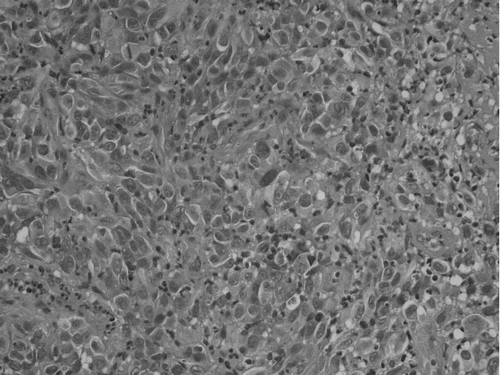To the Editor
A rectal mucosal melanoma is a rare but highly malignant neoplasm affecting females more often than males. Most of them are located in the distal rectum and appear as a polypoid or fungating intraluminal mass. The disease has aggressive biological behavior and is usually advanced at presentation. The prognosis is poor due to early metastases and being refractory to therapeutic modalities Citation[1–3].
A 40 year old female with anal bleeding mimicking a hemorrhoid was found to have a tumor in the rectum by digital examination. A diagnosis of a malignant melanoma was made after a tissue biopsy (). 18F-fluoro-deoxyglucose (FDG) PET for initial staging demonstrated focally increased uptake in the rectum and bilateral inguinal lymph nodes (A, B). In addition, there was nodular uptake in the posterior left upper thorax (C), consistent with a hot spot seen on the MDP bone scan (D), which was considered to be a metastatic rib lesion.
Figure 1. Tissue pathology of the biopsied specimen showing a picture of a malignant melanoma with solid nests infiltrating into the mucosa, superficial ulceration, moderate nuclear pleomorphism, and focal pigmentation. Immunohistochemical study revealed that the tumor was positive for HMB-45 and negative for cytokeratin.

Figure 2. Whole-body PET was performed 45 min after an intravenous injection of 300 MBq FDG using a Siemens ACCEL PET scanner. Additional 3-h-delayed images after emptying the urinary bladder were also obtained. (A) Maximal intensity projection (MIP) imaging revealing focal increases in FDG uptake in the bilateral inguinal regions and in the posterior aspect of the left upper thorax. The rectal region was obscured by the full urinary bladder. (B) Delayed image in the sagittal and coronal sections revealing focal increase activity in the rectum (upper and middle), and a transverse section revealing FDG uptake in the rectum and bilateral inguinal lymph nodes (lower). The maximal standard uptake value (SUVm) of the rectal lesion was 5.9. (C) Coronal section of the thorax revealing a focal area with increase FDG uptake. A corresponding finding was observed in the posterior view of the Tc-99m MDP bone scan which showed a solitary hot spot in the left 4th rib (D).

FDG-PET accompanied by sentinel node biopsy is a novel modality for the staging and restaging of cutaneous malignant melanomas Citation[4–7]. A few cases regarding its utility in mucosal malignant melanomas have been reported in the literature. To our knowledge, this is the first report of a case of a malignant melanoma arising from the rectum with FDG uptake Citation[8–10]. Although a lesion with infectious process may present with enhanced glucose metabolism and increase FDG uptake, a previous report concerning human papilloma virus which could often be isolated from ano/rectal mucosa as an etiological factor for emerging malignant melanoma in sun sheltered areas, was not identified Citation[11].
References
- Cagir B, Whiteford MH, Topham A, Rakinic J, Fry RD. Changing epidemiology of anorectal melanoma. Dis Colon Rectum 1999; 42: 1203–8
- DeMatos P, Tyler DS, Seigler HF. Malignant melanoma of the mucous membrane: A review of 119 cases. Ann Surg Oncol 1998; 5: 733–42
- Batsakis JG, Suarez P. Mucosal melanomas: A review. Adv Anat Pathol 2000; 7: 167–80
- Weinstock MA. Epidemiology and prognosis of anorectal melanoma. Gastroenterology 1993; 104: 174–8
- Belhocine TZ, Scott AM, Even-Sapir E, Urbain JL, Essner R. Role of nuclear medicine in the management of cutaneous malignant melanoma. J Nucl Med 2006; 47: 957–67
- Kumar R, Mavi A, Bural G, Alavi A. Fluorodeoxyglucose-PET in the management of malignant melanoma. Radiol Clin N Am 2005; 43: 23–33
- Gulec SA, Faries MB, Lee CC, Kirgan D, Glass C, Morton DL, et al. The role of fluorine-18 deoxyglucose positron emission tomography in the management of patients with metastatic melanoma: Impact on surgical decision making. Clin Nucl Med 2003; 28: 961–5
- Chamroonrat W, Zhuang H, Houseni M, Mavi A, EI-Haddad G, Bhutain C, et al. Malignant lesions can mimic gastric uptake on FDG PET. Clin Nucl Med 2006; 31: 37–8
- Vandewoude M, Cornelis A, Wyndaele D, Brussaard C, Kums R. 18)FDG-PET-scan in staging of primary malignant melanoma of the oesophagus: A case report. Acta Gastro-Ent Belg 2006; 69: 12–4
- Goerres GW, Stoeckli SJ, von Schulthess GK, Steinert HC. FDG PET for mucosal malignant melanoma of the head and neck. Laryngoscope 2002; 112: 381–5
- Dahlgren L, Schedvins K, Kanter-Lewensohn L, Dalianis T, Ragnarsson-Olding BK. Human papilloma virus (HPV) is rarely detected in malignant melanomas of sun sheltered mucosal membranes. Acta Oncol 2005; 44: 694–9
